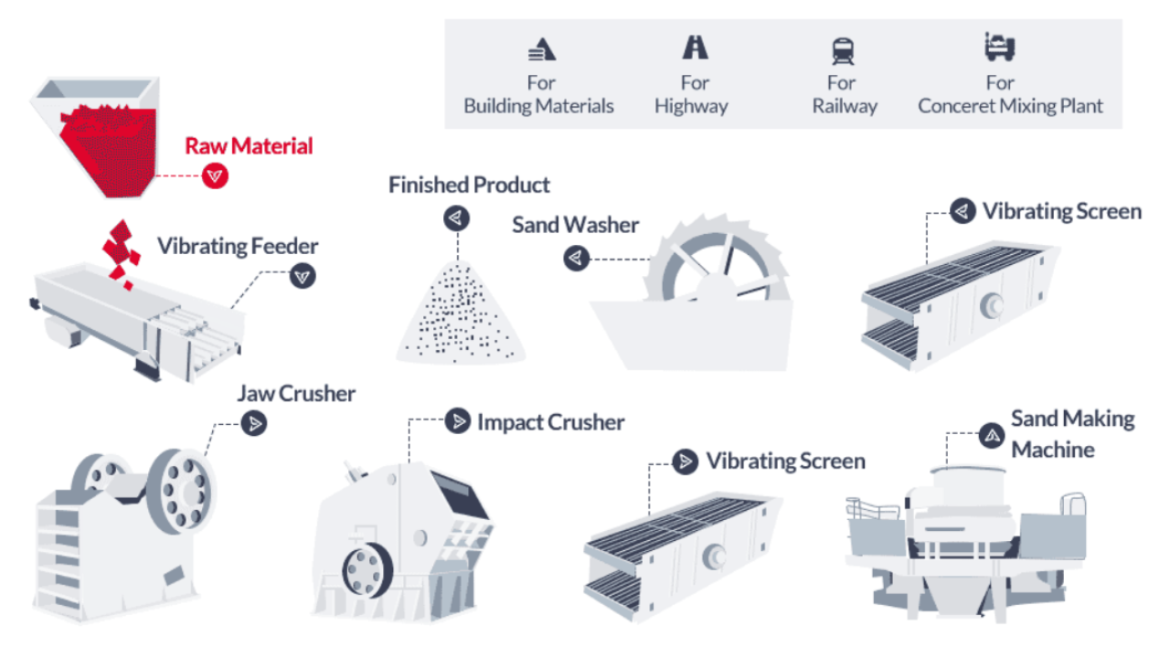Aggregate quality is crucial in construction, as well as infrastructure projects. The durability and stability of roads and buildings require high-quality aggregates. In aggregate production, such crushing and screening plant are essential to meet the increasing demands for such materials. They process raw materials to produce aggregates that vary in size, shape, and strength, which is critical to construction practice.
The Role of Crushing Plants in Aggregate Quality Enhancement
The aggregate quality is assured through the crushing process, the first step. This involves breaking large rocks down into smaller, manageable chunks. It is divided into the primary, secondary, and tertiary stages. Primary crushing is the first stage of material reduction. It consists of reducing the size of the material to a thickness that can be processed through equipment like a cone crusher or impactor. Refining the size further is accomplished by secondary crushing in cone crushers, reducing the material even more. Finally, tertiary crushing with VSI sand makers refines the material to high-quality sand.
Achieving the correct particle size and shape is critical and relies on precision crushing. The aggregates ‘ correct texture, shape, and size are essential for their performance in construction projects, and a well-executed crushing process is required to produce aggregates. For instance, jaw crushers are rough but can be made into usable material, while cone crushers and VSI sand makers provide smooth material to create aggregates that have ideal properties.
Screening Plants: Ensuring uniformity and granularity.
Crushing and screening are equally crucial in assuring the quality of aggregate. The material then has to be crushed and separated into different sizes to follow some standards. At this point, screening plants come in useful. These plants use vibrating screens to sort the aggregates by size. They are necessary when a uniform product is required so that the aggregates comply with the required specifications to be used for various construction purposes.
Screening also minimizes impurities; oversized and undersized materials are removed. When done, screening ensures that only high-quality aggregates make it to the end product since consistency is key. Without this step, the final product could have undesirable particles, compromising its performance and durability.
Types of Crushing and Screening Equipment for Quality Control
To achieve the desired aggregate quality, the right equipment is needed. Their basic structure and working principle are as follows: Jaw crusher works by compressing materials, which are struck on one end by a hammer; this relies on impact energy as the materials are hit and bounced from the other side of the hammer it is repeated, and the process continues until materials are crushed to your desired size and shape. The VSI sand makers refine these materials into delicate and uniform sand sizes. The purpose of each crusher is unique; hence, each crusher helps achieve the perfect size and shape of aggregates.
Vibration screens ensure the material is separated into consistent sizes. Technological advancements in screening have made these machines more efficient, reducing the time and energy needed. Sand washers or sand classifiers are also crucial since they help remove dust and dirt to make the final product cleaner.
Crushing and screening optimization
The equipment for crushing and screening operations should be selected to maximize their effectiveness when processing different types of material. Each of the limestone, granite, and basalt needs its equipment to get the best results. Conveyor systems are also important since they help smooth material passing from crushers and screens to allow for continuous and efficient operation.
The process is further optimized through automation and monitoring systems, which allow operators to monitor the equipment’s performance. These systems adjust settings in real-time to ensure the aggregate quality remains consistent throughout production.
Aggregate Characteristics Impact
This is how crushing and screening directly affect aggregates’ size, shape, and strength. When the crushing and screening process is more precise, the final product will perform better in construction. Imagine how more substantial and durable structures can be obtained through aggregates with a more uniform shape due to proper crushing. It ensures that the aggregate used delivers the best performance by ensuring that only the size of the aggregates is correctly screened.
Environmental and Cost Advantages of Advanced Crushing and Screening
Modern crushing and screening plants have some environmental and cost-saving benefits. These plants contribute to sustainable practices in the construction industry by reducing waste and efficiently exploiting raw materials. Further, advanced equipment is increasingly used to minimize energy consumption and reduce operational costs while producing high-quality aggregates.
Conclusion
Using a crushing and screening plant improves aggregate quality and provides countless benefits, such as complying with construction standards and lowering operational costs. The plants are specialized to ensure that aggregates are uniform, durable, and suitable for different construction purposes. The future of aggregate production looks even more efficient and environmentally friendly with continued technological advancements. With the adoption of these technologies, the construction industry will be able to meet the soaring demand for high-quality aggregates.
